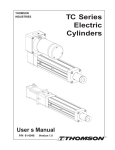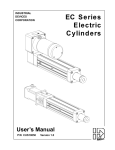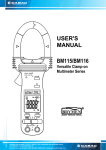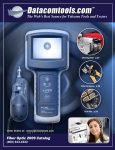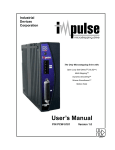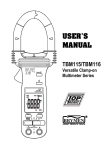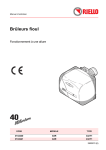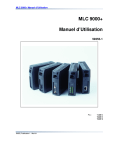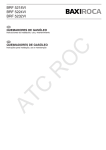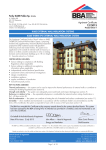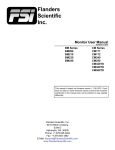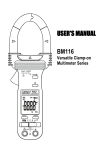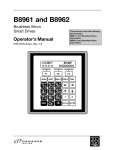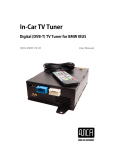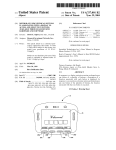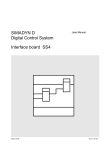Download EC Series Electric Cylinders
Transcript
EC Series Electric Cylinders User's Manual P/N CUS10050 Rev. 1.0 07/03 Table of Contents 1. PRODUCT OVERVIEW .................................................................................................................... 1 EC SERIES FEATURES ......................................................................................................................1 EC SERIES SPECIFICATIONS .............................................................................................................1 EC ELECTRIC CYLINDER CONSTRUCTION (TYPICAL) ..........................................................................2 2. CYLINDER PART NUMBERS - IDENTIFYING A CYLINDER ........................................................ 3 IDENTIFY YOUR EC CYLINDER USING THE CYLINDER CONFIGURATION GUIDE .....................................3 3. EC SERIES SPECIFICATION AND CONFIGURATION REFERENCE .......................................... 6 4. MOUNTING YOUR EC CYLINDER ................................................................................................. 9 MOUNTING REQUIREMENTS ...............................................................................................................9 ATTACHING THE LOAD TO THE ROD END .........................................................................................10 ALIGNING THE ELECTRIC CYLINDER TO THE LOAD ............................................................................11 INSTALLING POSITION SENSORS FOR OVERTRAVEL PROTECTION .....................................................12 POSITION SENSOR DIMENSIONS AND MOUNTING LOCATIONS ............................................................13 5. APPLICATION CONSIDERATIONS ..............................................................................................15 COLUMN LOAD LIMIT .......................................................................................................................15 CRITICAL SPEED LIMIT ....................................................................................................................16 DUTY-CYCLE LIMITS .......................................................................................................................16 ENVIRONMENTAL SPECIFICATIONS ...................................................................................................17 PREVENTING EXPOSURE TO CONTAMINANTS ...................................................................................17 INSTALLING A VENT TUBE FITTING (INCLUDED WITH ALL EC CYLINDERS) ...........................................17 6. OPTIONAL EQUIPMENT - SPECIFICATIONS, DIMENSIONS, AND WIRING ............................19 BRAKE ON LEADSCREW OPTION (-BS24, -BS115, -BS230) ............................................................19 BRAKE ON MOTOR OPTION (-BM24, -BM115, -BM230) ..................................................................20 ENCODER OPTION (-EMK/-EM) ......................................................................................................21 LINEAR POTENTIOMETER OPTION (-L) .............................................................................................22 7. FACTORY SERVICE AND ROUTINE FIELD MAINTENANCE .....................................................23 PERFORMING INSPECTIONS AND ROUTINE MAINTENANCE .................................................................23 ROUTINE MAINTENANCE PROCEDURES ............................................................................................24 PREVENT INJURY TO PERSONNEL ....................................................................................................24 HARDWARE TORQUE .......................................................................................................................24 LUBRICANTS AND ADHESIVES ..........................................................................................................24 INSTALLING A PULLEY, PINION, REVERSE PINION, OR COUPLING ......................................................25 SPACING REQUIREMENTS ...............................................................................................................26 LUBRICATING THE LEADSCREW .......................................................................................................27 CHECKING/ADJUSTING DRIVE BELT TENSION ...................................................................................28 LUBRICATING GEARS ......................................................................................................................29 ALIGNING MOTOR PINION ................................................................................................................30 8. MOUNTING A CUSTOMER-SUPPLIED MOTOR .........................................................................31 9. TROUBLESHOOTING ...................................................................................................................33 10. PARTS LIST AND EXPLODED PARTS DIAGRAMS ................................................................. 39 EXPLODED PARTS DIAGRAM - EC2/EC3 PARALLEL MOTOR MOUNTING .....................................40 - 43 EXPLODED PARTS DIAGRAM - EC2/EC3 INLINE MOTOR MOUNTING ..........................................44 - 47 EXPLODED PARTS DIAGRAM - EC4/EC5 PARALLEL MOTOR MOUNTING .....................................48 - 51 EXPLODED PARTS DIAGRAM - EC4/EC5 INLINE MOTOR MOUNTING ..........................................52 - 55 11. WARRANTY AND SERVICE COVERAGE ..................................................................................57 INDEX..................................................................................................................................................59 i EC Electric Cylinder - User s Manual 1. Product Overview IDC s EC Series Electric Cylinders are designed for use in a wide variety of industrial, scientific, and commercial applications requiring precise control of linear thrust, speed, or position. This manual will help you install, operate, and maintain your EC Series Cylinder. EC Series Features From the EC2 to the EC5, the EC series is IDC s highest performance line of electric cylinders. Following are several features that make the EC the cylinder of choice for the most demanding applications: · Robust design for highest loads and longest life possible · Precision rolled ballscrews for smoothness and accuracy · Environmentally sealed - All standard versions of EC cylinders are IP54 rated. An IP65-rated, Protective Boot (-PB) option is available on all EC cylinders. This optional thrust tube boot prevents moisture and dry contaminants from bypassing the thrust tube wiper seal. · Metric dimensions in accordance with ISO6431 - Meets the needs of customers who manufacture for the international marketplace. Both English and Metric versions of threaded mounting options are standard. · ACME screws available on the EC2 and EC3 versions. EC Series Specifications Specifications vary for the four basic EC configurations (EC2, EC3, EC4, EC5). Please refer to Section 3, EC Series Specification and Configuration Reference for specification parameters and configurations. 1 EC Electric Cylinder - User s Manual EC Electric Cylinder Construction (Typical) This cross-section of an EC4 cylinder, with parallel motor mounting, is provided to illustrate the typical components of an IDC electric cylinder. Refer to Section 10, Parts List and Exploded Parts Diagrams, for a more detailed breakdown of EC cylinders. 2 1 11 3 10 4 5 6 1. Motor (may be customer supplied) 2. Drive Housing 3. Drive Train (belt drive shown) 4. Thrust Bearings 5. Leadscrew 6. Drive Nut 7 5 8 7. Internal Guide Flange (including magnets) 8. Rod End Bearing 9. Rod End Wiper 10. Thrust Tube 11. Guide Cylinder 2 9 EC Electric Cylinder - User s Manual 2. Cylinder Part Numbers - Identifying a Cylinder Your new EC cylinder will arrive with an IDC factory label attached as shown below. The factory label provides a detailed breakdown of the cylinder model with all of its mechanical characteristics. This section can be used to: 1) identify a cylinder s mechanical characteristics based on the factory label, or 2) order a new EC cylinder with different mechanical characteristics. Label Location Locations of Labels on Different Motor-Mounting Configurations Label 7C Raymond Avenue Label Salem, NH 03079 TEL: 800-227-1066 www.DanaherMotion.com Parallel Electric Cylinder Model: EC3-P32-15-05B-50-MS2-MT1E-BS-L Serial Number: XXXXX XXXX XX X Voltage: XXX V Rated Current: XX A Inline Model Number Example Rod-Type Cylinder EC3 EC3 = B23 = 15 = 05B = 50 = Base Model Number Drive Motor Ratio Type B23 15 Screw Pitch, Type 05B Stroke Length 50 Product Series NEMA 23 Frame, Brushless Servo Motor 1.5 to 1 Drive Ratio - Belt/Pulley 5 mm Lead Ballscrew 50-inch stroke Cylinder Mounting MS2 MS2 = MT1E = BS = L= Rod End MT1E Options BS L Side Lugs Mounting Male Threaded Rod End - English Threads Brake on Screw Option Linear Potentiometer Option Identify Your EC Cylinder Using the Cylinder Configuration Guide This fill-in-the-box section is provided for users who want to identify an existing EC cylinder or perhaps order a new EC cylinder. To identify the mechanical characteristics of an existing EC cylinder, photocopy this page and transcribe the model number from the factory label to boxes 2 through 8. To reconfigure or order a new EC, fill in boxes 2 - 8 with codes for the new cylinder. Refer to the Cylinder Configuration Guide on the following pages for boxes 2 - 8. See IDC s latest catalog or website (www.idcmotion.com) for more information. Base Model Number Rod-Type Cylinder Motor Type Drive Ratio Screw Pitch, Type 2 3 4 Stroke Lengt h Cylinder Mounting Rod End Options 5 6 7 8 EC3 1 3 EC Electric Cylinder - User s Manual Cylinder Configuration Guide 2 Motor Type D 24VDC, 4.5 Amp, Permanent Magnet Motor H 160VDC, 2 Amp, Permanent Magnet Motor H4 160VDC, 5 Amp, Permanent Magnet Motor P22[*x] NEMA 23 Frame, Step Motor, 3 Stack P32[*x] NEMA 34 Frame, Step Motor, 2 Stack S32[*x] NEMA 34 Frame, Step Motor, 2 Stack S42[*x] NEMA 42 Frame, Step Motor, 2 Stack B23 NEMA 23 Frame Brushless Servo Motor B32 NEMA 34 Frame, Brushless Servo Motor B41 NEMA 42 Frame, Brushless Servo Motor X 3 Drive Ratio Customer-Supplied Motor (motor described in Options element of part number) 10 1.0:1 Drive Belt/Pulley (1.0:1 exact ratio) 15 1.5:1 Drive Belt/Pulley (1.5:1 exact ratio) 20 2.0:1 Drive Belt/Pulley (2.0:1 exact ratio) 50 5.0:1 Drive Belt/Pulley (5.0:1 ratio) *70 7.0:1 Drive Belt/Pulley (7.0:1 ratio) 100 10.0:1 Helical Gear (10.1 exact ratio) 10L 1.0:1 Inline Coupling (Direct 1:1 coupling is the only ratio available for Inline Models) *EC3 only 4 Screw Type 04A 4 mm/rev ACME leadscrew 05B 5 mm/rev ballscrew 10B 10 mm/rev ballscrew 16B 16 mm/rev ballscrew 25B 25 mm/rev ballscrew 32B 32 mm/rev ballscrew 5 Stroke Length 4 Specified in Millimeters *Insert one of the following codes for X: N = 8 leads (windings can be wired in Series or Parallel) T = Pre-wired in Series V = Pre-wired in Parallel EC Electric Cylinder - User s Manual Cylinder Configuration Guide 6 Mounting Styles MF1 MF2 MF3 Front Rectangular Flange Rear Rectangular Flange Front & Rear Rectangular Flange MP2 MP3 Rear Double Clevis Mount (shown) Rear Double Clevis Mount with Pivot Base MS1 Side End Angles MS2 Side Lugs MS6M Side Tapped Mounting Holes MS6E MT4 7 Rod Ends Trunnion Mount FC2 Clevis (includes MT1M) FS2 Spherical Joint (includes FT1M) FT1M FT1E Female Thread MT1M Male Thread MT1E Note: Rod-End dimensions can be found in the latest IDC Catalog or on our website www.idcmotion.com 8 Cylinder Options BM[*x] Brake on Motor BS[*x] Brake on Leadscrew EMK L Encoder on Motor (1000 line) Linear Potentiometer LR Linear Rod Bearing (EC2 only) PB Protective Boot *Insert one of the following codes for X: 24 = 24 VDC Brake 115 = 115 VAC Brake 230 = 230 VAC Brake Motor Mod Codes for X Motors (customer supplied) also found in option part of Part Number 5 EC Electric Cylinder - User s Manual 3. EC Series Specification and Configuration Reference EC2 - Specifications Parameter Motor Type Max Load Capacity EC2-D EC2-H EC2-S32/P22 EC2-B23 24 VDC Brushed 160 VDC Brushed 1.8ß Hybrid Stepper Brushless Servo N [lbs] 3230 [740] Max No Load Speed mm/s [in/s] Repeatability mm [in] 3600 [810] 840 [33] 930 [36.5] 800 [31.5] –0.13 [–0.005] –0.013 [–0.0005] D2200 D2300 D2400 D2500B SmartStep Compatible IDC Controls Performance Curves 1280 [50.5] B8961 See Latest IDC Catalog or www.idcmotion.com Configurations and Options Available - See Cylinder Configuration Guide for explanation of codes below Drive Ratio 10, 15, 20, 50, 100, 10L Screw Type Stroke Length 04A, 05B, 16B mm 50, 100, 150, 200, 250, 300, 450, 600, 750; Custom lengths available in 1 mm increments Cylinder Mounting MF1, MF2, MF3, MS1, MS2, MP2, MP3, MS6M, MS6E, MT4 Rod End FT1M, FT1E, MT1M, MT1E, FC2, FS2 Options -BS, -EMK, -L, -LR, -PB -BM, -BS, -EMK, -L, -LR, -PB -BS, -EMK, -L, -LR, -PB -BM, -BS, -L, -LR, -PB EC3 - Specifications Parameter Motor Type Max Load Capacity EC3-P32 EC3-B23/B32 160 VDC Brushed 1.8ß Hybrid Stepper Brushless Servo N [lbs] Max No Load Speed mm/s [in/s] Repeatability EC3-H mm [in] 7200 [1620] 930 [36.5] 800 [31.5] –0.025 [–0.001] 1280 [50.5] –0.013 [–0.0005] Compatible IDC Controls SmartStep Performance Curves B8961 See Latest IDC Catalog or www.idcmotion.com Configurations and Options Available - See Cylinder Configuration Guide for explanation of codes Drive Ratio 10, 15, 20, 50, 70, 10L Screw Type Stroke Length Cylinder Mounting Rod End Options 6 04A, 05B, 10B, 16B mm 50, 100, 150, 200, 250, 300, 450, 600, 750, 1000; Custom lengths available in 1 mm increments MF1, MF2, MF3, MS1, MS2, MP2, MP3, MS6E, MT4 FT1M, FT1E, MT1M, MT1E, FC2, and FS2 -BM, -BS, -EMK, -L, -PB -BS, -EMK, -L, -PB -BM, -BS, -L, -PB EC Electric Cylinder - User s Manual EC4 - Specifications Parameter Motor Type Max Load Capacity Max No Load Speed EC4-H4 EC4-P32 EC4-B32 160 VDC Servo 1.8ß Hybrid Stepper Brushless Servo N [lbs] 12000 [2700] mm/s [in/s] Repeatability mm [in] Compatible IDC Controls 1330 [52.5] –0.025 [–0.001] –0.013 [–0.0005] H4301B H4321B H4501 Performance Curves NextStep SmartStep S6002 S6961 S6962 B8001 B8961 B8962 See Latest IDC Catalog or www.idcmotion.com Configurations and Options Available - See Cylinder Configuration Guide for explanation of codes Drive Ratio 10, 15, 20, 50, 100, 10L Screw Type 10B, 25B Stroke Length mm Cylinder Mounting 50, 100, 150, 200, 250, 300, 450, 600, 750, 1000, 1500; Custom lengths available in 1 mm increments MF1, MF2, MF3, MS2, MP2, MP3, MS6M, MS6E, MT4 Rod End FT1M, FT1E, MT1M, MT1E, FC2, FS2 Options -BM, -BS, -EMK, -L, -PB -BS, -EMK, -L, -PB -BM, -BS, -L, -PB EC5 - Specifications Parameter Motor Type Max Load Capacity Max No Load Speed EC5-S42 EC5-B32/B41 1.8ß Hybrid Stepper Brushless Servo N [lbs] 25000 [5620] mm/s [in/s] Repeatability 1330 [52.5] mm [in] –0.013 [–0.0005] Compatible IDC Controls SmartStep Performance Curves B8961 See Latest IDC Catalog or www.idcmotion.com Configurations and Options Available - See Cylinder Configuration Guide for explanation of codes Drive Ratio 10, 15, 20, 50, 100, 10L Screw Type 10B, 32B Stroke Length Cylinder Mounting Rod End Options mm 50, 100, 150, 200, 250, 300, 450, 600, 750, 1000, 1500; Custom lengths available in 1 mm increments MF1, MF2, MF3, MS2, MP2, MP3, MS6M, MS6E, MT4 FT1M, FT1E, MT1M, MT1E, FC2, FS2 -BS, -EMK, -L, -PB -BM, -BS, -L, -PB 7 EC Electric Cylinder - User s Manual This page intentionally left blank 8 EC Electric Cylinder - User s Manual 4. Mounting Your EC Cylinder Warning! Ensure that power to the electric cylinder is OFF before attempting any installation, adjustment, or modification of the cylinder mounting, rod end attachment, or the load. Mounting Requirements 1. 2. 3. 4. 5. CAUTION! When using pivot-mounting options (MP2, MP3, or MT4) with a pivot rod-end (FS2 or FC2), it is recommended that the cylinder not be extended more than 95% of its full stroke. This increases the system s rigidity and extends the life of the guide bearings and rod seal. The structure on which the cylinder is mounted must be capable of holding three times (3X) the cylinder load and be rigid enough to prevent undue deflection or distortion of the cylinder or its supporting members. The cylinder must be mounted parallel to the travel of the load to ensure proper alignment (this is especially important with externally guided loads using rails, bearings, etc.). All mounting surfaces must be flat and clean to provide for secure and stable fittings. Units with flat surface mounts (MF1, MF2, MF3, MS1, MS6) must be rigidly mounted. Cylinder Mounting Styles Each cylinder mounting style presents different application considerations. Find your mounting style(s) in the table below and pay special attention to the corresponding Application Requirements column. Cylinder Mounting Style Application Requirements MF1 - Front Flange Not recommended for use in horizontal applications with stroke lengths greater than 300 mm unless there is additional support in the rear of the cylinder. MF2 - Rear Flange Not recommended for use in horizontal applications with stroke lengths greater than 300 mm unless there is additional support in the front of the cylinder. MF3 - Front & Rear Flange Do not allow the body of the cylinder to twist while aligning the front and rear mounting flanges to their mating surfaces. MP2 - Rear Clevis Use a flexible rod end or load attachment to compensate for system misalignment. Example: FC2, FE2, or FS2 rod ends MS1 - Side End Angle Brackets Each mounting screw must be able to withstand a peak shear-force of 4488 N (EC2); 8896 N (EC3); 15569 N (EC4); 26689 N (EC5). MS2 - Side Lugs Each mounting screw must be able to withstand a peak shear-force of 4488 N (EC2); 8896 N (EC3); 15569 N (EC4); 26689 N (EC5). MS6 - Side Tapped Holes Each mounting screw must be able to withstand a peak shear-force of 4488 N (EC2); 8896 N (EC3); 15569 N (EC4); 26689 N (EC5). MT4 - Trunnion Mount Use a flexible rod end or load attachment to compensate for system misalignment. Mounting Rod Ends As with mounting styles, different rod ends also require certain application considerations. Find your rod end(s) in the table below and pay special attention to the corresponding Application Requirements column.. Rod End Style Application Requirements FC2 - Clevis w/MT1 Thread Clevis must be secured by its locknut when in desired position. The mounting pin must be secured with a cotter pin after it is inserted into the double clevis holes. FS2 - Spherical Joint Not recommended if stiff or rigid load attachment is required. FT1 - Female Thread Any attachment to an FT1 rod end must be secured in place by a locknut. MT1 - Male Thread Any attachment to an MT1 rod end must be secured in place by a locknut. 9 EC Electric Cylinder - User s Manual Attaching the Load to the Rod End Warning! Do Not Exceed the Maximum Torque Limits on the Thrust Tube when attaching the load to the rod end. Failure to heed this warning could cause irreparable damage to the internal guide flange. Maximum torque limits are shown on the drawing below. Hexagonal flats are provided at the end of the thrust tube to prevent rotation while the rod end attachment is being secured. Maximum Torque EC Series A B N-m ft-lbs N-m ft-lbs EC2 68 50 27 20 EC3 88 65 41 30 EC4 163 120 68 50 EC5 163 120 68 50 Do Not Exceed A ft-lbs torque in the Clockwise (CW) direction 10 Do Not Exceed B ft-lbs torque in the Counter Clockwise (CCW) direction Use wrench on flats to prevent rotation of thrust tube during load attachment EC Electric Cylinder - User s Manual Aligning the Electric Cylinder to the Load Load-travel alignment is critical for the prevention of binding and premature wear of internal components. The following alignment procedures and specifications have been developed for users who demand the highest level of precision and longest life from their IDC electric cylinders. Alignment Using MF1, MF2, MF3, MP2, MP3, or MT4 Cylinder Mounting Styles 1. 2. 3. 4. 5. 6. Ensure that the mounting surface is within X millimeters from perpendicular to the travel of the guided load. See illustrations below. Mount the cylinder loosely to the mounting surface, i.e. all mounting screws are installed but they are loose enough to allow the cylinder to move in the mounting. Attach the guided load system to the cylinder rod end. Reduce as much weight as possible from the guided load system. Run the cylinder for 5 to 10 cycles, allowing the cylinder to align itself to the guided load system. Tighten the cylinder mounting screws according to the torque specifications for your specific hardware. EC Series X mm inches load travel EC2 0.03 .001 Mounting Surface EC3 0.04 .0015 EC4 0.05 .002 X EC5 0.05 .002 Mounting Surface load travel X Alignment Using MS1, MS2, or MS6 Cylinder Mounting Styles 1. 2. 3. 4. 5. 6. Ensure that the mounting surface is within X millimeters from parallel to the travel of the guided load. See table and illustration below. Mount the cylinder loosely to the mounting surface, i.e. all mounting screws are installed but they are loose enough to allow the cylinder to move from side to side. Attach the guided load system to the cylinder rod end. Reduce as much weight as possible from the guided load system. Run the cylinder for 5 to 10 cycles, allowing the cylinder to align itself to the guided load system. Tighten the cylinder mounting screws according to the torque specifications for your specific hardware. Cyl. Length mm [in] X mm [in] 50 [2] 100 [4] 150 [6] 200 [8] 250 [10] 300 [12] 450 [18] 600 [24] 750 [30] 1000 [40] 1250 [50] 1500 [60] 0.04 [.002] 0.06 [.002] 0.08 [.003] 0.10 [.004] 0.12 [.005] 0.14 [.006] 0.20 [.008] 0.26 [.010] 0.32 [.013] 0.42 [.017] 0.52 [.020] 0.62 [.024] load travel X Mounting Surface 11 EC Electric Cylinder - User s Manual Installing Position Sensors for Overtravel Protection Although an elastomeric spring inside the cylinder is designed to prevent cylinder jams, position sensors (aka limit switches) are required to prevent such potentially damaging jam conditions. If the motor is accidentally commanded to move toward a hard-stop, position sensors can signal a stop before a collision occurs. To work properly, position sensors must be positioned inward from the hard-stop, and wired correctly to the motor controller. Note: Using the physical limits of the cylinder (hard stops) will reduce cylinder life and can cause premature component failure. Position Sensor Specifications for Sensors Used on EC Electric Cylinders Sensor Series Sensor Type Output Type Connection LED Color PSR-1 PSR-2 PSN-2 Contact Closure *PSP-2 Sinking, Open Collector (NPN) Sourcing (PNP) Norm. Closed Norm. Open Norm. Closed Norm. Open Norm. Closed Green Red Green Red Yellow Red 2 + shield, 26 AWG, 3 meters Voltage 8-120V (AC or DC) 3 + shield, 26 AWG, 3 meters 5, 12, or 24 VDC Current 5 mA @ 12 VDC; 10 mA @ 24 VDC Power 0.24 W Leakage Current (max) Output *PSP-1 Hall-Effect Norm. Open Leads (wiring) Supply PSN-1 Mechanical Reed 0.01 mA DC Maximum 120VDC AC Maximum 120VAC 8-30VDC Current Max. 40mA 100mA Power Max. 5W 3W Operating Temp. -4ß to 158ßF [-20ß to 70ßC] Storage Temp. -4ß to 176ßF [-20ß to 80ßC] Environmental Rating ITC Standard IP67 *Not compatible with IDC s motion controllers Mounting Location - Deceleration Distance The position sensor s location along the cylinder is associated with the beginning of a deceleration, not the final stopping point. Therefore, position sensors must be mounted inward of the cylinder hard-stops to provide a slowdown area to prevent jamming. The faster the approach speed, the longer it takes to stop the cylinder, so deceleration distance varies with cylinder speed, load, and cylinder/control type. A small amount of adjustment may be necessary during initial setup. Important Installation Notes 1. 2. 3. 4. Position sensors may be mounted along either side of an EC cylinder. Labels (example POSITION INDICATING shown) indicate the sides of the cylinder where position sensors can be installed. MAGNET THIS SIDE Distance between sensors should be 1.50 inches or more. If sensors are located closer than 1.50 inches apart, they could trigger at the same time. Using position sensors for end-of-travel protection reduces effective travel distance. Consult the factory. IDC’s D2200, D2300 and D2400 series controls use only PSR-1 and PSN-1 position sensors. CAUTION When installing a position sensor, tighten the clamp screw to a maximum 7.0 oz-in of torque. Failure to heed this caution could cause irreparable damage to the sensor. Tighten the clamp screw gently and only to the point where the sensor assembly feels secure and does not slide along the cylinder wall. 12 EC Electric Cylinder - User s Manual Position Sensor Dimensions and Mounting Locations The illustrations below show sensor mounting locations when cylinder magnet and sensor are physically aligned. These locations are recommended as a starting point when setting up a cylinder for the first time. Depending on the speed and payload of the application, sensors may be moved inward to prevent a hard-stop crash when the load travels at full speed past a limit switch. See Caution on previous page before attempting to tighten the installation screws on a position sensor Top View of TC Cylinder Internal Magnets Sensors Dimensions A and B are approximate end-ofstroke locations for the position sensors. Phillips-Head Screw 11.2 [0.44] EC Series Dim A mm [in] Dim B mm [in] EC2 73.3 [2.90] 48.3 [1.90] EC3 77.0 [3.03] 56.6 [2.23] EC4 137.0 [5.39] 63.0 [2.48] EC5 137.0 [5.39] 63.0 [2.48] B A 9.9 [0.39] 29.5 [1.16] Side View of TC Cylinder Sensor-to-Controller Connections The sensor connection diagrams below show wiring color codes and controller inputs for connecting each type of position sensor. PSR Reed Sensor Controller 2-Conductor Shielded Cable Internal Supply Brown Blue Controller Inupt Note: The black wire in Quick Disconnect cables is not used with any version of the PSR (Reed) sensor. In the above drawing, only the blue wire, brown wire, and shield are connected. COM Shield Sensor (Reed) Detector PSN Hall-Effect Sensor Controller 3-Conductor Shielded Cable +12/24V Brown DC Supply Controller Input Black Blue COM Shield Sensor (Hall-Effect) Controller 3-Conductor Shielded Cable Brown Detector *PSP Hall-Effect Sensor +12/24V Controller Input *PSP sensor is not compatible with IDC controls. Black Blue DC Supply COM Shield Sensor (Hall-Effect) 13 EC Electric Cylinder - User s Manual This page intentionally left blank 14 EC Electric Cylinder - User s Manual 5. Application Considerations Certain conditions can limit cylinder performance and should be addressed prior to installation and operation. Adherence to the following application guidelines will ensure a successful application. Column Load Limit Exceeding the Column Load Limit will cause the leadscrew to buckle and become permanently damaged. The Load Limit Table below contains Column Load Limits per stroke length and screw type. Thrust Load Compression (column) Load Load Limit Table for Standard Stroke Lengths *Column Load Limit (N) per EC Series with Applicable IDC Screw Type in Parentheses EC Cylinder Stroke Length EC2 EC3 2500 (04A) 4900 (16B) EC4 EC5 50 - 600 mm 750 mm 1000 mm 2780 (16B) 4650 (04A) 5340 (10B) 6530 (05B) 1250 mm 10300 (10B) 1500 mm 7400 (10B) 8600 (25B) *Shaded areas indicate NO Column Loading Restriction (for example: Column Load Limits do not apply to any length of EC5 cylinder or to 32B Screws). Column Load Limits for Custom Stroke Lengths If you require a Column Load Limit for a custom stroke length between 750 and 1500 mm, consider the following options: 5. Contact IDC Applications Engineering for a custom Column Load Limit. 6. Use the Column Load Limit for the next shorter stroke length. Example: for an EC3 of 1100 mm with an 04A screw, use 4650 N. 15 EC Electric Cylinder - User s Manual Critical Speed Limit All leadscrew systems have a critical speed at which harmonic vibrations begin to occur. Sustained operation beyond this critical speed limit (see tables below) may cause the leadscrew to vibrate or whip violently, eventually bending or warping the screw (see illustration). Observing the maximum speed limits in the tables below will help prevent damage to your EC cylinder. L Maximum Speed per Cylinder Stroke Length (Speed = mm/sec) Screw Type 50 - 200 mm 300 mm 450 mm 600 mm EC2 EC3 EC4 EC5 EC2 EC3 EC4 EC5 EC2 EC3 EC4 EC5 EC2 EC3 EC4 EC5 04A 233 200 219 200 119 144 72 89 05B 414 261 310 261 172 199 103 119 10B 16B 25B 32B 533 388 1280 533 993 1333 388 866 398 550 239 530 1333 1333 388 331 350 318 1059 1333 263 Table continued 657 1333 1120 Note: Shading indicates non-applicability. Important Note: IDC programmable controls have a maximumvelocity parameter that can be configured not to exceed the critical speed. Screw Type Maximum Speed per Cylinder Stroke (Speed = mm/sec) 750 mm 1000 mm 1250 mm 1500 mm EC2 EC3 EC4 EC5 EC3 EC4 EC5 EC4 EC5 EC4 EC5 04A 48 61 05B 71 84 10B 16B 25B 32B 212 230 33 48 185 254 216 96 119 156 63 99 53 72 127 462 298 814 171 499 131 316 229 Duty-Cycle Limits Duty-cycle is the percentage of ON Time divided by Total Cycle Time for the worst-case 10-minute period. During operation, duty-cycle represents the maximum acceptable power dissipation of the motor and the frictional heat losses of the internal cylinder components, primarily the leadscrew/drivenut assembly. In general, ballscrew cylinders are rated for 100% duty cycle and ACME screws are rated for a maximum of 60%. Your motor may also have duty-cycle limitations. Consult your IDC Catalog or www.idcmotion.com for more information on dutycycles. Exceeding the recommended duty-cycle will damage the motor or internal cylinder components. 16 EC Electric Cylinder - User s Manual Environmental Specifications The following environmental specifications must be observed for optimal cylinder performance: Temperature Rating - The operational temperature range for all EC cylinders is -30ß to 70ß C [-22ß to 158ß F]. When operating below 2ß C [35ß F], a vent tube must be installed (see below). Preventing Exposure to Contaminants Liquids: Standard EC cylinders are water-resistant for environments with a slight mist on the cylinder body but not on the thrust tube. If liquid or moisture contaminates internal components, damage may occur. Standard EC cylinders are IP54-rated. The IP65-rated Protective Boot option (-PB) is available to protect the thrust tube/wiper interface. The standard EC cylinder provides a seal between the motor and cylinder body, but does not protect the motor itself. For applications where exposure is unavoidable with a corrosive liquid or a pressurized liquid, an external protective enclosure is recommended. Consult the factory for assistance. Solid Particles: Rod-type cylinders are generally well protected against particle contaminants. For environments with exposure to fine or abrasive particles, the standard EC cylinder provides added resistance to entry by sealing mating surfaces with gaskets during assembly. The Protective Boot (-PB) option is recommended when the thrust tube/sleeve bearing interface is exposed to abrasive particles or water spray. Installing a Vent Tube Fitting (included with all EC cylinders) A Vent Tube is required when: · Any EC cylinder is equipped with the -PB option. · Operating any EC cylinder below 2ß C [35ßF]. · Operating any non PB-equipped EC cylinder in an environment of solid contaminants (i.e. dust, paper, or wood particles). 3. Connect tubing (customer-supplied) to the vent tube fitting. See table for size of tubing required. 4. If the cylinder has the -PB option and/or is being operated below 2ß C [35ß F], connect the other end of the tubing to a non-contaminated air source of 0 psi. Installation 1. Remove breather plug from all cylinders except EC4 and EC5 with -PB option. 2. Install white plastic vent tube fitting. EC4 and EC5 with Protective Boot (-PB) Option EC2, EC3, EC4, EC5 Vent Tubing Sizes If the cylinder does not have the -PB option, and is being operated in an environment of solid contaminants, connect the other end of the tubing to a non-contaminated positive pressure source of 2 to 3 psi. EC Series EC2 and EC3 Size Tubing Required 1/4-inch inside diameter EC4 and EC5 3/8-inch inside diameter EC4 and EC5 with PB option 3/4-inch inside diameter 17 EC Electric Cylinder - User s Manual This page intentionally left blank 18 EC Electric Cylinder - User s Manual 6. Optional Equipment - Specifications, Dimensions, and Wiring Brake on Leadscrew Option (-BS24, -BS115, -BS230) This brake option provides a spring-set, electrically-released friction brake mounted to an extension of the leadscrew. It prevents backdriving when the unit is at rest, or in case of power failure. The brake is engaged when power is not applied. Applying power releases the brake, allowing motion to occur. Application Note: This option is used only for in-position holding, it should not be used for stopping a moving load. Specifications Specification Parameters Voltage Power Watts Holding Torque N-m [in lbs] Cable Length m [ft] Holding Force with -BS Brake Option Leadscrew-Mounted Brake Configurations -BS24 -BS115 -BS230 24 VDC 115 VAC 230 VAC EC2=12.5 EC3=7 EC4/5=15 EC2=3.9 [35] EC3=6.7 [60] EC4/5=39.2 [350] 3.7 [12] EC Configuration Screw Type Holding Force EC2 16B Ball (16 mm/rev) 1550 N [350 lbs] 05B Ball (5 mm/rev) 3600 N [810 lbs] 04A ACME (4 mm/rev) 3600 N [810 lbs] EC3 16B Ball (16 mm/rev) 2660 N [600 lbs] 10B Ball (10 mm/rev) 4260 N [960 lbs] 05B Ball (5 mm/rev) 7200 N [1620 lbs] 04A ACME (4 mm/rev) 7200 N [1620 lbs] EC4 25B Ball (25 mm/rev) 9940 N [2230 lbs] 10B Ball (10 mm/rev) 12000 N [2700 lbs] EC5 32B Ball (32 mm/rev) 7770 N [1750 lbs] 10B Ball (10 mm/rev) 24800 N [5590 lbs] .23 Quick-Disconnect Cable 1.50 Minimum Bend Radius Dimensions .57 H Brake Cover D EC Series L EC2 EC3 EC4/EC5 Electrical Connections + Brake Dim D Dim H 78.2 [3.08] 155.1 [6.10] 97.3 [3.83] 183.3 [7.22] 141.7 [5.58] 245.0 [9.64] Dim L 69.3 [2.73] 84.3 [3.32] 99.9 [3.94] 115 VAC (-BS115) 230 VAC (-BS230) Rectifier Coil – Brake 24 VDC (-BS24) Coil 19 EC Electric Cylinder - User s Manual Brake on Motor Option (-BM24, -BM115, -BM230) The motor shaft-mounted brake can be an advantage because brake torque is multiplied by the belt or gear reduction and does not interfere with certain rear cylinder-mounting options. A broken drive belt will render the motor-mounted brake inoperable. Note: This is a static brake, intended only for in-position holding. It should not be used for routinely stopping a moving load. Brake on Motor Specifications Parameter Brake Specifications per Cylinder Configuration Cylinder EC2-H, EC3-H, EC4-H EC2-B EC3-B EC4-B EC5-B Motor Type H, H4 B23 B23 B32 B32 B32 B41 Brake Type -BM24 -BM115 -BM230 -BM24 -BM24 -BM24 Voltage 24 VDC 115 VAC 230 VAC 24 VDC 24 VDC 24 VDC Current Amps 0.25 0.05 0.03 0.21 0.52 0.88 Power Watts 6 5 12.48 21.12 Holding Torque N-m [in-lbs] 1.1 [10] 1.1 [10] 6.7 [60] 27 [240] Cable Length m [ft] 3.7 [12] See Note Below Holding Force Consult the Factory Note: Brake wiring included in B23 motor cable. Motor cable available in 12, 25, and 50-foot lengths. Dimensions H4 Motor with Brake H Motor with Brake 3.7 m [12'] Brake Cable 106.7 [4.20] 79.25 [3.12] 190 [7.48] MAX 221.49 [8.72] B23 Motor with Brake B32 Motor with Brake 50.8 [2.00] MAX SQ 57.15 [2.25] 63.5 [2.50] MAX SQ 84.07 [3.31] 201.9 [7.95] MAX B41 Motor with Brake Electrical Connections + Brake 260.1 [10.24] MAX 71.12 [2.80] MAX 115 VAC (-BM115) 230 VAC (-BM230) Rectifier Coil SQ 127.99 [5.00] – 266.95 [10.51] MAX + Brake 24 VDC (-BM24) Coil – 20 Note: Observe polarity when using a -BM24 Brake with a B23, B32, or B41 Motor. EC Electric Cylinder - User s Manual Encoder Option (-EMK/-EM) The encoder option for EC-applicable motors provides an incremental rotary encoder, factory-mounted directly to the rear of the D, H, P22, P32, S32, and S42 IDC motors. The -EMK encoder is an industry-standard, 1000-line version, and the -EM is the 500-line version. The digital pulse output is used to provide position feedback to external devices such as motor controllers, counters, or PLC s. A 2000-line encoder is standard equipment on the B23, B32, and B41 motors. Specifications per EC-Applicable IDC Motor Parameter Pulses per Revolution Output Pulse Format Cable Length/Type Voltage Current Max. Speed Weight m [ft] kg [oz] D, H, P22, S32, S42, Motors P32 Motor *B23, B32, B41 Motors -EMK 1K line (4K post-quad) -EMK 1K line (4K post-quad) 2000 line (8000 post-quad) -EM 500 line (2K post-quad) -EM 500 line (2K post-quad) Incremental, Dual Square Wave Quadrature, with Index Pulse 3.7 [12]/Leads 3.7 [12]/Leads 3.7 [12]/MS Connector 5 VDC –5% 120 mA 135 mA 200 mA 6000 rpm 12000 rpm 6000 rpm 0.17 [6.0] .057 [2.0] 0.25 [8.8] [oz-in-sec2] 5.1 x 10-9 [7.3 x 10-7] 3.1 x 10-7 [4.4 x 10-5] Operating Temp. …C […F] -10 to +70 [+14 to +158] -10 to +100 [+14 to +212] Storage Temp.e …C […F] -20 to +80 [-4 to +176] -30 to +110 [-22 to +230] *Not an option. Encoder is standard equipment on these motors. Inertia kg-m2 1.0 x 10-6 [1.4 x 10-4] -20 to +100 [-4 to +212] -25 to +100 [-13 to +212] Dimensions P32, S32, S42, B32, B23, and B41 Motors: Encoder is enclosed within the standard motor housing - no dimensional changes. H Motor D, P22 Motor 30.48 [1.2] 25.4 [1.00] 79.8 [3.14] 54.1 [2.13] Encoder Cover Encoder Cover Encoder Connections Motors: D, H, P22, P32, S32, S42 Signal Color Code Signal Motors: B23, B32, B41 Color Code (See Note) A+ Red A+ Blue Blue Blue A- Pink or Purple A- Blue/Black Yellow Blue/White B+ Green B+ Green Yellow/White Yellow B- Blue B- Green/Black Red/ White Yellow/White Z+ Yellow Z+ Violet Blue/White Brown Z- Orange Z- Violet/Black Black/White Brown/White +5 VDC White +5 VDC Red Red Red COM Black COM Black Black Black Note: Due to different cable suppliers, your encoder cable will contain one of three possible color codes. Each column represents a color code for a different cable. Find the color code that matches your cable and use that column only. 21 EC Electric Cylinder - User s Manual Linear Potentiometer Option (-L) The Linear Potentiometer resides within the cylinder housing and is energized by an external DC power supply. The potentiometer wiper moves in conjunction with the cylinder thrust tube providing an analog voltage feedback signal which is proportional to the linear displacement. Example: Using a 5 volt supply, 0VDC = 0% Stroke; 2.5VDC = 50% Stroke; and 5 VDC = 100% Stroke Application Notes 1. This option is not recommended for high vibration environments. 2. This option is required when the EC is used with IDC D2500, H3500, H4500, and B8500 series controls. Specifications Stroke (mm) Resistance (ohms) 50 3000 – 20% –1% 100 6000 – 20% –1% 150 9000 – 20% –1% 200 9000 – 30% –1% 250 9000 – 30% –1% 300 7000 – 30% –1% (5% to 95% of function) 450 7000 – 30% –1% (5% to 95% of function) 600 7000 – 30% –1% (5% to 95% of function) 1.18 [30.0] Dimensions (Linear Pot top-mounted on EC cylinder) Max. Non-Linearity 0.50 [12.7] A Cable: 0.17 [4.3], R0.51 [13.0] Minimum Bend Radius B EC Cylinder Model EC2 EC3 EC4 EC5 Electrical Connections +VDC Wiper Feedback GND DIM A mm [in] 37.3 [1.47] 43.7 [1.72] 54.5 [2.15] 54.5 [2.15] Brown Black Blue Shield 22 DIM B mm [in] 28.5 [1.12] 34.8 [1.37] 46.1 [1.82] 46.1 [1.82] EC Electric Cylinder - User s Manual 7. Factory Service and Routine Field Maintenance While we recommend factory service in most cases, we recognize that it may occasionally be necessary to perform minor repairs or maintenance in the field. Such cases include replacing worn or broken components (i.e. belts, rod ends, or mounting hardware) and lubrication of leadscrew or gears as required in extreme applications. All routine maintenance procedures must be performed by qualified personnel, using only IDC-supplied or IDC-recommended parts and supplies. Improper routine maintenance which causes damage or premature wear will void the factory warranty. The table below is provided as a quick reference to help users decide whether to return a unit to the factory or allow qualified personnel to perform routine maintenance in the field. Factory Service Required Routine Maintenance Procedures Page # Belt/Pulley Ratio Conversion (1:1, 1.5:1, 2:1) Pulley and Pinion Installation Helical Gear System Ratio Conversion (5:1 and 10:1) Lubricating the Leadscrew (excluding -BS and -L options) 22-23 24 Leadscrew Modification Checking and Adjusting Drive Belt Tension* 25 Motor Orientation Modification Lubricating Gears 26 Mounting or Rod End Modification *Aligning Motor Pinion 27 Cylinder Option Modification (-BS and -L) Any Repair to Motor Pulley, Drive Belt, Gear, Motor Pinion, Intermediate Gear, or Inline Coupling/Sleeve *This procedure was developed for users of IDC motors, but it may also be applicable to certain customer-supplied motors. Performing Inspections and Routine Maintenance · Why Perform Inspections and Routine Maintenance in the Field? Periodic inspection and routine maintenance can extend the life of your cylinder, especially under extreme operating conditions. · What are Extreme Operating Conditions? Applications such as continuous high speed operation, high speed stops/starts, or exposure to harsh environments. · When Should Routine Maintenance be Performed? In such extreme applications, it is recommended that the leadscrew and gears be re-lubricated, and an internal inspection be completed every *1,000,000 inches of cylinder travel. Inspection/re-lubrication typically consists of partial disassembly, followed by cleaning, visual evaluation, and lubrication. *EC2 and EC3 cylinders with ACME leadscrews operating in high load/high duty-cycle applications should be re-lubricated every 200,000 inches of travel (see page 24). 23 EC Electric Cylinder - User s Manual Routine Maintenance Procedures Routine maintenance procedures are provided in the remainder of this section. Order parts and supplies from your local IDC Distributor. Prevent Injury to Personnel Do not attempt to perform any routine maintenance procedure while power is connected to the motor/ cylinder. Hardware Torque Before attempting any routine maintenance procedure, become familiar with the Torque Specification Table below. Always refer to this table before applying torque to any of the listed parts. Torque Specification Table Description of Part Reference # (see Exploded Parts Diagrams) Screw, Guide Cylinder Hardware Size Maximum Torque (N-m) Maximum Torque (in-lbs) 17, 33, 53 M5X.8 M6X1 M10X1.5 4.24 9.9 41 50.89 87.62 362.86 Screw, Set 22, 36 M4X.7 M6X1 0.94 4.3 8.32 38.06 Screw, Set, Coupling 4, 58 10-24 UNC 1/4 - 20 UNC 2.83 4.53 25.05 40.09 Screw, Motor Mounting 39 M4X.7 M5X.8 M6X1 2.9 5.75 9.9 25.67 50.89 87.62 Screw, Cover Plate 18 M4X.7 M5X.8 M6X1 2.9 5.75 9.9 25.67 50.89 87.62 Lubricants and Adhesives When a specific lubricant or adhesive is required, it will be specified within the applicable procedure. 24 EC Electric Cylinder - User s Manual Installing a Pulley, Pinion, Reverse Pinion, or Coupling Refer to the applicable illustration and dimensions table on the following page for your pulley, pinion, reverse pinion, or coupling placement. 1. Clean the motor shaft and bore free of any grease. 2. Apply Loctite #680 (green) to the motor shaft and the bore of the pulley, pinion, or coupling. 3. Slide pulley, pinion, reverse pinion, or coupling onto the motor shaft with a rotating motion to evenly distribute the Loctite. 4. See Application Note # 2. Position the pulley, pinion, reverse pinion, or coupling according to the applicable drawing and table on the following page. 5. Ensure that one setscrew is positioned on a flat, in a dimple, over a key or keyway. 6. Apply Loctite #262 (red) to the setscrew(s). 7. Tighten setscrew(s). 8. Refer to the motor-mounting procedure on page 28. Application Notes 1. WARNING! The combination of pulley placement and operating torque may exceed motor shaft-load capacity. It is the user s responsibility to verify adequate shaft-load capacity. 2. If a supplemental mounting plate or adapter is used, it must be installed before measuring pulley, pinion, reverse pinion, or coupling spacing. 3. All spacing dimensions for pulleys, pinions, reverse pinions, or couplings have a tolerance of –0.13 mm (–.005 inches). 25 EC Electric Cylinder - User s Manual Spacing Requirements Pulley Spacing A EC Series Pulley spacing A must be measured from the inner face of the pulley to the face of the mounting plate (see App. Note #2) Pinion Spacing Coupling spacing D must be measured from the inner face of the coupling to the face of the mounting plate (see Application Note) 26 EC2 D, H, P22, S32, B23, NEMA 23/34 11.63 [0.458] EC3 D, H, P32, S32, B23/32, NEMA 23/34 13.08 [0.515] EC4 H4, P32, S32, B32, NEMA 34/42 18.06 [0.711] EC5 H4, P32, S32/42, B32/41, NEMA 34/42 18.06 [0.711] EC Series Motors EC2 S32, P22, NEMA 23/34 Dimension B mm [in] 9.40 [0.370] B23 3.68 [0.145] EC3 D, P32, S32, B23/32, NEMA 23/34 3.30 [0.130] EC4 H4, P32, S32/42, B32, NEMA 34/42 2.82 [0.111] EC5 P32, S32/42, B32, NEMA 34/42 2.82 [0.111] EC Series Motors EC2 H & D only 6.73 [0.265] EC3 H only 10.67 [0.420] EC4 N/A N/A EC5 H4 & B41 only 15.72 [0.619] EC Series Motors EC2 D, H, P22, S32, B23, NEMA 23/34 EC3 D, H, P32, S32, B23/32, NEMA 23/34 7.62 [0.300] EC4 H4, P32, S32, B32, NEMA 34/42 8.79 [0.346] EC5 H4, P32, S32/42, B32/41, NEMA 34/42 8.79 [0.346] C C must be measured from the inner edge of the pinion to the face of the mounting plate (see App. Note #2) Coupling Spacing (inline motors) Dimension A mm [in] B B must be measured from the inner edge of the pinion to the face of the mounting plate (see App. Note #2) Reverse Pinion Spacing Motors Dimension C mm [in] D Dimension D mm [in] 8.00 [0.315] EC Electric Cylinder - User s Manual Lubricating the Leadscrew In high-load and/or high duty-cycle applications, EC2 and EC3 cylinders with ACME screws should be relubricated every 200,000 inches of travel. All other EC cylinders should be re-lubricated every 1,000,000 inches of travel. EC2 and EC3 cylinders with ACME screws, and all EC4 and EC5 cylinders include a lube port and lube adapter (nozzle) for a standard lubrication dispenser (grease gun). Note: Do not attempt to lubricate the leadscrew of a cylinder with the -L (Linear Potentiometer) Option. This procedure must be done at the factory. Recommended Lubricants Type of Leadscrew Type of Lubricant Ballscrews with 05B, 10B, 16B, 25B, and 32B Screws NLGI Grade 2, Synthetic Base Lithium Grease ACME Screws with Bronze ACME Nut (04A Screws) NLGI Grade 2, Synthetic Base Grease with PTFE Additive Lubricating EC2/EC3 Ballscrews 1. Remove upper rear cover plate from the gear housing (EC2 only) by removing two (2) SHCS. 2. Remove main rear cover plate by removing four (4) SHCS. 3. Loosen two (2) SHCS (inside gear housing) that secure the upper part of the guide housing. These screws must be loosened in consecutive increments; i.e. 2 turns on one screw, then 2 turns on the other, repeating until each is loose. Note: these are captive screws and cannot be removed as shown in the illustration below. 4. Remove guide housing by sliding it away from the thrust tube. 5. Move the drive nut (attached to thrust tube) to the far end of the leadscrew. 6. Remove as much of the old grease from the leadscrew as possible. 7. With most of the leadscrew exposed, apply no more than 0.8 mm (.03’’) of the recommended lubricant over the length of the screw. Run the drivenut over the screw length to spread the grease evenly. Wipe off any excess grease expelled from the leadscrew by the drivenut. 8. Reassemble Unit. Note: After lubricating the leadscrew, check belt tension on belt-driven cylinders (next page). 1 4 5 6 3 2 Lubricating EC2/EC3 ACME Screws and All EC4/EC5 Ballscrews 1. Remove lube plug. 2. Move cylinder to center stroke. 3. Install the IDC-supplied lube nozzle on your lube dispenser (aka grease-gun). 4. Insert lube nozzle through lube opening and onto the grease fitting. 1 5. Caution- Do Not Overfill the Leadscrew with Grease! Pump only 2.3 to 2.8 grams (.08 to 1.0 oz) of grease per 304.8 mm (12 inches) of cylinder travel into the leadscrew. 27 EC Electric Cylinder - User s Manual Checking/Adjusting Drive Belt Tension 1. Ensure power to the motor is OFF and the load is removed from the thrust tube. 2. Remove rear cover plate(s) as necessary for your particular EC cylinder. 3. Using finger pressure, push the drive belt inward. The belt should not deflect more than 3.17 mm (.125 inch) from a stationary centerline. If the drive belt deflects more than 3.17 mm (.125 inch), proceed to the following section that applies to your motor. Adjusting Belt Tension on D and H Motors 1. Loosen two (2) motor-adjustment screws inside drive housing (shown below left) just enough to allow the motor to move. Both screws are in slots which allow up/down movement of the motor to change belt tension. 2. Move the motor up or down to adjust belt tension. While maintaining proper tension by hand, tighten both screws. Check belt tension again and reassemble unit. Adjusting Belt Tension on P22, P32, S32, S42, B23, B32, and B41 Motors 1. Loosen four (4) external motor mounting/adjustment screws (shown below right) just enough to allow the motor to move. All screws are in clearance holes which allow just enough up/down movement to adjust the belt tension. 2. Move the motor up or down to adjust belt tension. While maintaining proper tension by hand, tighten all screws. Check belt tension again and reassemble unit. D/H/H4 Motors Motor Adjustment Screw P22/P32/S32/S42/B23/B32/B41 Motors Motor Adjustment Screw Motor 3.17 mm (.125’’) Maximum Belt Deflection 28 Motor Mounting/ Adjustment Screw (4) EC Electric Cylinder - User s Manual Lubricating Gears Recommended Lubricant: NLGI Grade 2, Synthetic Base Lithium Complex EP Grease 1. Remove rear cover plate(s) as necessary for your particular EC cylinder. Note: Cylinder with -BS (Brake on Leadscrew) option requires removal of the top cover plate only on EC2 cylinders. 2. Remove as much of the old grease from the gears as possible. 3. With the gears exposed, apply an ample amount of lubricant (6.35 mm [.25 in] or more) to all surface contact areas of gear train as shown in the illustration below. Reassemble unit. 3 29 EC Electric Cylinder - User s Manual Aligning Motor Pinion 1. Ensure power to the motor is OFF and the load is removed from the thrust tube. 2. Remove rear cover plate(s) as necessary for inspection. For cover plate removal, refer to steps 1 and 2 in Lubricating Gears earlier in this section. Reinstall cover plate(s). Aligning Motor Pinion on D, and H Motors (shown below) 1. Loosen two (2) mounting/alignment screws just enough to allow the motor to move. Both screws are in slots which allow up/down movement of the motor to align the motor pinion. 2. Move the motor pinion into the fully-meshed or seated position against the intermediate gear (i.e. pinion will not move any farther). See #2 in photo below. 3. From the fully-meshed position, back off or move the pinion gear away from the intermediate gear 0.076 to 0.203 mm (.003 to .008 in). See #3 in photo below. 4. While maintaining proper position by hand, tighten mounting/alignment screws. Install upper cover plate. Aligning Motor Pinion on P22, P32, S32, S42, B23, B32, and B41 Motors 1. Loosen four (4) mounting/adjusting screws just enough to allow the motor to move. All screws are in clearance holes which allow just enough up/down movement to adjust the motor pinion. 2. Move the motor pinion into the fully-meshed or seated position against the intermediate gear (i.e. pinion will not move any farther). See step 2 on the D/H/H4 Motor photo. 3. From the fully-meshed position, back off or move the pinion gear away from the intermediate gear 0.076 to 0.203 mm (.003 to .008 in). See step 3 on the D/H/H4 Motor photo. 4. While maintaining proper position by hand, tighten mounting/alignment screws. Install upper cover plate. D/H/H4 Motors 2 .003 to .008’’ gap between pinion and intermediate gears 30 3 P22/P32/S32/S42/B23/B32/B41 Motors Mounting/Alignment Screw (2 screws on D & H motors; 4 screws on B and P Motors) Motor EC Electric Cylinder - User s Manual 8. Mounting a Customer-Supplied Motor This procedure is provided for the user who will be mounting a non-IDC motor on an EC Cylinder. For this procedure it is assumed that the EC cylinder has been received without a motor. 1. For parallel-mounted motors only, remove rear cover plate(s) from the gear housing (EC2 cylinders have two covers; all other EC cylinders have a one-piece cover plate). 2. Remove motor-mounting screws and washers from the cylinder motor mount. Note: If motor mounting screws and washers are not installed in the motor mount, they can be found packaged in a separate bag. 3. Install the motor pulley, gear pinion, or inline coupling per the installation procedure in section 7. 4. Using the following method appropriate to your application, insert the motor shaft and motor pilot into the gear housing through the hole in the mounting plate. Drive Belt: As you slide the motor and pulley through the mounting plate, lift the drive belt onto the teeth of the drive pulley. Refer to Checking/Adjusting Drive Belt Tension in section 7. Gear Drive: As you slide the motor and gear pinion through the mounting plate, gently engage and mesh the pinion with the intermediate gear. Refer to Aligning Motor Pinion in section 7. Inline Mounting: As you slide the motor and coupling through the mounting plate, rotate the motor coupling until it lines up the coupling sleeve inside the cylinder. 5. Continue to slide the motor shaft through the mounting plate until motor flange is flush with the motor mounting plate and the motor pilot is centered inside the mounting plate. 6. Secure the motor to the mounting plate using the motor mounting hardware previously removed. 1 3 2, 6 4, 5 31 EC Electric Cylinder - User s Manual This page intentionally left blank 32 EC Electric Cylinder - User s Manual 9. Troubleshooting This section offers assistance when troubleshooting basic electric cylinder problems related to mechanical operation. When troubleshooting electric cylinder problems, the cause may be related to the drive or motor used with the cylinder. Refer to your drive/control user s manual for additional assistance on troubleshooting your system. The following categories are covered in this section: A. B. C. D. E. Audible Noise Emitting from Cylinder Cylinder Motion Positioning and Travel Length Thrust Tube Cylinder Parts and Options Category/Symptom Possible Cause Possible Remedy A. Audible Noise Emitting from Cylinder Knocking, squealing or grinding during operation Misalignment of internal components Send back to factory for evaluation. Excessive Side-loading Check side-load rating. Reduce side-load. Internal lubrication dried Remove old lubricant. Re-lubricate the leadscrew and/or gears. Entry of foreign matter into cylinder body Send back to factory for evaluation. Load too great for cylinder/motor Check cylinder rating. Reduce load. Excessive thrust tube side-loading Check side-load rating. Reduce side load. Motor pulley, gear pinion, or coupling slipping Re-install pulley, gear, or coupling onto the motor. Erratic motor/controller operation Ensure functionality of the controller. Replace motor. B. Cylinder Motion Stalls/Binds/Sticks during a move (erratic motion) Send back to factory for evaluaDrive nut or internal bearing seizing (locking up) typically due to excessive tion. duty cycle/temperature or entry of foreign matter into cylinder Running rough, not running smoothly Misalignment of internal components Send back to factory for evaluation. Excessive side-loading Check side-load ratings. Reduce side-load. Internal lubrication dried Remove old lubricant. Re-lubricate the leadscrew and/or gear. Entry of foreign matter into cylinder body Send back to factory for evaluation. Extends when it should retract (and Motor polarity reversed visa versa) Reverse motor polarity at the control. 33 EC Electric Cylinder - User s Manual Category/Symptom Possible Cause Possible Remedy Vibrates during motion Motor Unstable (servo gains, stepper resonance) Reduce motor gain for servomotors. Increase step resolution for step motors. Cylinder being operated at critical speed Check critical speed limit. Reduce speed to less than critical speed. Misalignment of internal components Send back to factory for evaluation. Motor not connected or is damaged Reconnect the motor. Replace the motor. Load too great for cylinder/motor Check the load limit. Reduce the load. Problem with drive/control Check output of drive/controller. Gear pinion, pulley, or coupling not secured to motor shaft Secure gear pinion, pulley, or coupling to the motor shaft. Belt is loose or damaged Adjust belt tension. Replace belt Bad gear alignment Adjust gear pinion placement. Stripped teeth on gear Send back to factory for evaluation. Threads are stripped on the drive nut (ACME) Send back to factory for evaluation Load is too great for desired speed Ensure cylinder is being operated below the speed/thrust curve. Decrease the load. No motor movement when commanded to move Does not move (or is erratic) although motor is rotating Not running at rated speed Limited by critical speed (oscillation) of Check the critical speed limits. screw Reduce the speed. Incorrect screw pitch or drive ratio Enter the correct screw-pitch or drive ratio the controller. C. Positioning and Travel Length Cylinder backdriving (without holding torque on motor) Backdriving force generated by load is Check the rated backdriving force greater than the static holding capacity for the cylinder. Reduce backdriving force. of the cylinder Excessive external vibration Cylinder backdriving (with holding torque on the motor Not enough travel 34 Mounting requires modification to isolate or reduce vibration Backdriving force generated by load is Reduce backdriving force. greater than the holding capacity of the screw/nut of the cylinder and the holding torque of the motor Loss of motor holding torque (servo and steppers) Recycle power to the motor and controller Position-Sensors reducing actual travel Adjust sensors to increase cylinder travel without allowing cylinder to hit its internal hard-stop bumper. Excessive side-loading Check side-load rating for the cylinder. Reduce side-load. Customer mounting is physically limiting travel Re-design mounting EC Electric Cylinder - User s Manual Category/Symptom Possible Cause Possible Remedy Expected linear travel distance not corresponding to number of motor revs Incorrect screw pitch or drive ratio Check screw-pitch and drive ratio of the cylinder. Enter correct pitch and ratio in the controller Incorrect scaling factor (programmable controllers) Enter correct scaling factor in the controller Load varies from cycle to cycle. Change load to be more consistent from cycle to cycle Erratic Motor/Control operation Contact motor/control vendor for more information. Leadscrew or thrust tube is bent Send back to factory for evaluation Excessive wear on leadscrew/nut Send back to factory for evaluation Improper mounting of cylinder Ensure cylinder travel is aligned with the travel of the load Expected stop position not repeatable (in same direction) D. Thrust Tube Wobbles during extension Deflects too much during extension Leadscrew/nut or internal bearings are Send back to factory for evalua(Excessive lateral endplay) worn tion Bent thrust tube Excessive side-loading Check side-load rating. Reduce side load. Improper cylinder mounting Ensure that cylinder travel is in line with the travel of the load Load too great for cylinder Excessive side-loading Send back to factory for evaluation Improper cylinder mounting Rotates (excessive radial play) Internal guide flange is damaged Send back to factory for evaluation Thrust tube not fully engaged in the internal guide flange Rotate thrust tube clockwise until it stops turning. The maximum torque exerted on the thrust tube in ft-lbs is: EC2 [50], EC3 [65], EC4/5 [120]. Stuck in fully extended or retracted Drive nut physically jammed into end position of travel Remove rear cover(s) and rotate the leadscrew, gear, pulley, or coupling until the leadscrew turns freely. If jammed in extend, rotate CW. If jammed in retract, rotate CCW. Load too great for cylinder/motor Check cylinder load rating. Reduce load Excessive side loading Check side-load rating. Reduce side-load. Pulley, gear, or coupling slipping Re-install pulley, gear, or coupling onto the motor. Erratic motor/drive operation Contact motor/drive vendor for more information 35 EC Electric Cylinder - User s Manual Category/Symptom Possible Cause Possible Remedy Excessive axial endplay (system backlash) Leadscrew/nut is worn Send back to factory for evaluation Gears worn Send back to factory for evaluation Belt stretching Re-tension belt Motor torque is too great Reduce Accel and Decel E. Cylinder Parts and Options Drive belt breaking or gears stripping Reduce load Motor accel/decel too great for given load Reduce Accel or Decel Load is too great for cylinder Check load rating of cylinder. Reduce load. Excessive shock loading (running into Reduce Accel/Decel of cylinder. physical hardstop, rapid change in Stop motion just before the hard direction) stop. Position Sensors not being activated by internal magnet Misalignment of internal components Send back to factory for evaluation Weak or missing internal magnet Send back to factory for evaluation Switch/sensor is damaged or miswired Check/correct switch wiring Send back to factory for evaluation Linear Potentiometer (LP) not reading properly Motor overheating Brake not holding load 36 Cylinder speed too fast Reduce cylinder speed LPO wiper lifting off track (misalignment or LP bending due to excessive load Ensure cylinder travel is in line with travel of the load Damaged / contaminated LP (by liquid/particle) Send back to factory for evaluation Duty cycle too high Check duty cycle rating. Reduce duty cycle High ambient temperature Use an external fan to cool the motor Incorrect current setting on drive Check the control/drive user s manual for correct current settings. Reset the control/drive with correct current setting. Brake not coupled to motor or leadscrew properly Send back to factory for evaluation Load exceeds holding capacity of cylinder/brake Check brake load rating. Reduce the load. Brake damaged Send back to factory for evaluation Brake wired incorrectly Check wiring and make corrections or repairs Reduce load EC Electric Cylinder - User s Manual Category/Symptom Possible Cause Possible Remedy Encoder reading improperly Encoder damaged Send back to factory for evaluation Encoder wired incorrectly Check wiring and make corrections or repairs Incorrect supply voltage to encoder Check encoder voltage rating. Ensure correct voltage is supplied to the encoder. 37 EC Electric Cylinder - User s Manual This page intentionally left blank 38 EC Electric Cylinder - User s Manual 10. Parts List and Exploded Parts Diagrams Parts can be ordered through your local IDC distributor. Kits include all essential parts and instructions. Item numbers below correspond with numbered items on the Exploded Parts Diagrams (see following pages). Reference # on Exploded Parts Diagram Description of Part Reference # on Exploded Parts Diagram Description of Part 1 Nut, Jam, Rear 33 Screw, Guide Cylinder, Front 2 Washer 34 Motor 3 Key, Pulley, Gear, or Coupling 35 Key, Motor Pulley, Gear, or Coupling 4 Pulley, Gear, or Coupling 36 Drive Pulley or Gear Pinion 5 Washer, Rear Bearing 37 Gasket, Motor 6 Plate, Motor Mounting 38 Washers, Lock, Motor Mounting 7 Gasket, Bearing Housing 39 Screw, Motor Mounting 8 Bearing, Leadscrew 40 Belt, Timing 9 Bearing Housing 41 Washers, Flat, Motor Mounting 10 Washer, Front Bearing 42 Spacer, Motor 11 Leadscrew 43 Spacer, Gear, Motor Side 12 Bumper, Rear 44 Bearing, Idler 13 Drive Nut 45 Shaft, Idler Gear 14 Bushing, Leadscrew 46 Gear, Idler, 1st Stage 15 Drive Housing 47 Spring, Wave 16 Gasket, Drive Housing 48 Spacer, Gear, Non-motor Side 17 Screw, Guide Cylinder, Upper, Rear 49 Gear, Idler, 2nd Stage 18 Screw, Cover Plate 50 Label, IDC Serial Tag 19 Guide Flange Body 51 Plate, Cover, Main 20 Guide Flange Bushings 52 Label, IDC Decal 21 Magnet, Limit Switch 53 Screw, Guide Cylinder, Lower, Rear 22 Screw, Set 54 Cover, Motor shaft 23 Lube fitting 55 Screws, Cover, Motor shaft 24 Thrust Tube 56 Plate, Cover, Upper Quick Disconnect 25 Rod End 57 26 Guide Cylinder 58 Coupling, Drive 27 Breather 59 Sleeve, Coupling 28 Plug, Lube 60 Spacer, Bumper 29 Bumper, Front 61 Spacer, Thrust Tube 30 Shield, Pinion Spacer, Quick Disconnect Rod End Housing 62 31 Bearing, Rod End 63 32 Wiper, Rod End 39 EC Electric Cylinder - User s Manual Exploded Parts Diagram - EC2/EC3 Parallel Motor Mounting 7 12 8 10 8 6 9 3 7 4 2 29 10 1 61 14 1 2 19 21 (x2) 11 60 40 13 20 (x4) EC Electric Cylinder - User s Manual Exploded Parts Diagram - EC2/EC3 Parallel Motor Mounting 18 (x4) 24 16 22 (x2) 15 23 33 (x4) 32 31 17 (x2) 30 7 26 28 25 27 41 EC Electric Cylinder - User s Manual Exploded Parts Diagram - EC2/EC3 Parallel Mounting S32 Motor B23 Motor 1:1, 1.5:1, 2:1 Drive Ratios 5:1, 10:1 Drive Ratios 39 (x4) 38 (x4) 41 (x4) 34 39 (x4) 38 (x4) 41 (x4) 36 37 34 6 36 37 37 43 (x4) 41 (x2) 38 (x2) 39 (x2) 45 (x2) 46 44 (x2) 48 (x2) 40 42 44 (x2) 49 EC Electric Cylinder - User s Manual Exploded Parts Diagram - EC2/EC3 Parallel Motor Mounting H Motor 55 (x2) B23 Motor 54 34 50 36 37 16 56 62 63 57 41 (x2) 38 (x2) 39 (x2) S23, H, & D Motors on TC2 Only 56 18 (x2) 51 18 (x2) 53 43 EC Electric Cylinder - User s Manual Exploded Parts Diagram - EC2/EC3 Inline Motor Mounting 60 7 10 9 12 8 10 2 8 29 1 1 61 14 2 19 21 (x2) 11 20 (x4) 13 44 EC Electric Cylinder - User s Manual Exploded Parts Diagram - EC2/EC3 Inline Motor Mounting 25 24 33 32 22 (x2) 31 23 30 7 26 28 27 45 EC Electric Cylinder - User s Manual Exploded Parts Diagram - EC2/EC3 Inline Motor Mounting 50 4 59 7 15 6 17 (x4) 7 18 6 46 EC Electric Cylinder - User s Manual Exploded Parts Diagram - EC2/EC3 Inline Motor Mounting 37 58 34 37 B23 34 41 (x4) 38 (x4) 39 (x4) 58 S32 47 EC Electric Cylinder - User s Manual Exploded Parts Diagram - EC4/EC5 Parallel Motor Mounting 8 10 8 9 6 7 4 2 3 5 1 2 14 2 12 1 13 11 48 7 EC Electric Cylinder - User s Manual Exploded Parts Diagram - EC4/EC5 Parallel Motor Mounting 18 (x4) 19 24 22 (x2) 21 (x2) 23 16 20 (x8) 32 30 33 (x4) 31 29 15 7 26 17 (x2) 28 27 25 49 EC Electric Cylinder - User s Manual Exploded Parts Diagram - EC4/EC5 Parallel Motor Mounting H4 Motor P32 Motor 1:1, 1.5:1, 2:1 Drive Ratios 5:1, 10:1 Drive Ratios 36 34 37 36 34 35 37 35 42 38 (x4) 39 (x4) 43 44 45 46 40 48 50 43 44 44 47 48 45 49 44 47 39 (x4) 38 (x4) 41 (x4) EC Electric Cylinder - User s Manual Exploded Parts Diagram - EC4/EC5 Parallel Motor Mounting 50 54 51 55 (x2) 18 ( x4) 16 53 (x2) 51 EC Electric Cylinder - User s Manual Exploded Parts Diagram - EC4/EC5 Inline Motor Mounting 8 10 8 9 2 2 5 1 2 1 14 12 13 11 52 7 EC Electric Cylinder - User s Manual Exploded Parts Diagram - EC4/EC5 Inline Motor Mounting 7 26 28 17 (x4) 27 15 24 25 22 (x2) 19 21 (x2) 32 3 23 20 (x8) 33 (x4) 30 31 29 4 7 53 EC Electric Cylinder - User s Manual Exploded Parts Diagram - EC4/EC5 Inline Motor Mounting P32 Motor 39 (x4) 38(x4) 41 (x4) 50 52 58 34 35 52 59 37 7 6 42 18 (x2) 54 EC Electric Cylinder - User s Manual Exploded Parts Diagram - EC4/EC5 Inline Motor Mounting H4 Motor 34 35 59 58 39 54 37 55 55 EC Electric Cylinder - User s Manual This page intentionally left blank 56 EC Electric Cylinder - User s Manual 11. Warranty and Service Coverage IDC warrants all EC Cylinders to be free of defects in material & workmanship for a period of one year from the date of shipment to the user. Products returned prepaid to the factory will be repaired or replaced at our option at no charge, and returned prepaid to the user. Products that fail due to improper use or misapplication are not subject to the terms of this warranty. Technical Support IDC offers technical support through its factory authorized and trained Distributors, and through its factory-based Applications Engineering and Inside Sales department. If an application problem exists or if the product has failed, contact your Distributor or IDC for technical assistance. Contact our factory at 1-800-227-1066, outside the U.S. at 603-893-0588. Factory Repair Service Product repairs are performed at our factory in Rohnert Park, California. Prior approval by IDC is required before returning a product for any reason. All returned products must be accompanied by an IDC supplied RMA (Return Material Authorization) number. In Case of Failure 1. Get the Model and Serial Number of the defective unit, and document the nature of the failure using the RMA Data Form to help us repair the unit. 2. Contact your IDC Distributor or IDC (at 1-800-227-1066) for an RMA#. 3. Prepare a purchase order for the repair cost in case the unit is out of warranty. 4. Ship the unit prepaid, with the RMA number and documentation to: Danaher Motion 7C Raymond Avenue Salem, NH 03079 Attn.: RMA # ___________ 57 EC Electric Cylinder - User s Manual This page intentionally left blank 58 EC Electric Cylinder - User s Manual Index A adjustment drive belt 28 alignment cylinder load 11 motor pinion 30 position sensors 13 attachment load to rod end 10 B brakes on leadscrew 19 on motor shaft 20 C column load limits 15 coupling installation 25 critical speed limits 16 cross-section of EC cylinder 2 customer-supplied motors mounting 31 cylinder options, how to specify 5 D drive belt tension checking and adjustment 28 drive ratios 4 E encoders specifications 21 environmental requirements 17 F factory service when required? 23 linear potentiometer specifications 22 load alignment 11 lubrication ACME screws 27 ballscrews 27 gears 29 M motor pinion alignment 30 motor types, how to specify 4 mounting requirements 9 mounting styles, how to specify 5 P part numbering scheme 3 parts list 39 pinion installation 25 position sensors mounting 13 specifications 12 pulley installation 25 R reverse pinion installation 25 rod end attachment maximum torque 10 rod ends, how to specify 5 routine maintenance hardware torque 24 lubricants and adhesives 24 perfoming inspections 23 procedures 23 S screw types, how to specify 4 specifications EC2, EC3 6 EC4, EC5 7 stroke length, how to specify 4 G gear lubrication 29 I identifying the mechanical characteristics of an EC cylinder 3 L leadscrew lubrication 27 T troubleshooting the cylinder cylinder noise 33 motion problems 33 parts and options 36 position and travel length 34 thrust tube 35 59 EC Electric Cylinder - User s Manual This page intentionally left blank 60 Danaher Motion 7C Raymond Avenue Salem, NH 03079 TEL: (800) 227-1066 ° FAX: (603) 893-8280 E-mail: [email protected] ° OUTSIDE THE U.S. CALL (603) 893-0588 Web Site: www.idcmotion.com































































